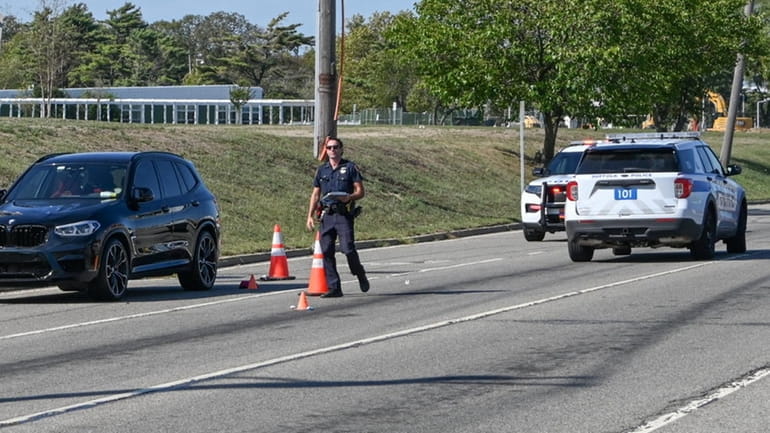Bigger cars pose bigger problems for safety of pedestrians and other drivers

A pedestrian was struck by an SUV that stayed at the scene on Route 110 in front of Farmingdale State College, in September 2022. Credit: Paul Mazza
The warning signals in traffic studies — connecting bigger vehicle sizes to increased pedestrian deaths — have been around for years. But they were of no help to Cathy Leary, a 75-year-old grandmother killed by a sport utility vehicle last October near her West Hempstead home.
Despite wearing a reflective vest to avoid a collision, Leary’s injuries from the SUV that hit her were so severe — broken ribs, punctured lungs, broken neck — that she never recovered. Her death, experts say, is consistent with those of many others killed by big vehicles, such as SUVs and pickups with taller front ends, that have become popular in recent years.
This trend in bulkier vehicles comes at a cost higher than just their sticker prices. While these vehicles with more size and heavier mass help protect the driver and passengers inside, they are also believed to be responsible for a rise in deaths and more severe injuries for pedestrians, cyclists and other drivers on the street.
Leary's death was another sad chapter in a frustrating litany of Long Island traffic deaths. Tank-like vehicles are among the many safety concerns for Long Islanders traveling on wheels or by foot. The situation could be helped by governmental changes, such as better-designed roadways. Those spending federal infrastructure money should keep pedestrian safety in mind with each project. Local streetscape makeovers should emphasize designs that slow down and calm aggressive drivers.
TIGHTEN ENFORCEMENT
But those changes won't address what seems to be lax enforcement of traffic rules and laws. In particular, annual vehicle inspections should check for proper headlights — their intensity and glare as well as their alignment. Far too many cars are blinding drivers coming from the opposite direction. High-beam glare is a menace and rules against it should be better enforced.
Fundamental safe driving skills also need greater emphasis on Long Island roadways. Speeding and dangerous weaving between lanes are causing more accidents. While traffic-light cameras shouldn't be used solely as moneymakers by municipalities, their power to prevent accidents should be embraced. There are plenty of straightaway roads where more cameras could help catch and prosecute speeding reckless drivers with little concern for whom they might hurt.
The need for more enforcement will become even more apparent as New York's legalization of marijuana increasingly takes effect. Driving under the influence of alcohol can be detected with roadside tests, but impairment from marijuana isn't as easy to discern with existing chemical tests. State officials need to examine the safety impact on the public of widespread use of marijuana and determine whether changes in the law are needed.
Problems with road design, lax enforcement, and lack of driving skills are exacerbated by the worrisome growing size of vehicles. A recent study in the journal Economics of Transportation, linking the hood height of vehicles and overall bigger size with deadlier consequences, is one of several examinations of this alarming trend. According to federal and state officials, more than 7,500 pedestrians were killed nationwide in 2022, the highest toll since 1981 and an increase of 75% since 2010. On Long Island, pedestrian deaths rose from 65 in 2018 to 72 in 2022.
NEW SAFETY RULES
Aware of these trends, the Biden administration and the National Highway Traffic Safety Administration last year proposed new guidelines that should help pedestrian safety. Though not moving quickly, this proposal is the right idea and should be embraced by all, including car manufacturers.
Under these NHTSA guidelines, cars will be examined for their ability to minimize the kind of devastating injuries that Leary suffered. The fronts of vehicles — particularly around the bumper, leading edge, windshield and hood — will be evaluated. The new rules are meant to encourage more energy absorption upon impact, as well as innovative front-end shapes and technologies that will better protect pedestrians if they are struck.
Once the rules are in place, the NHTSA will post on its website new vehicles that provide better pedestrian protection in a collision. It will use a pass/fail system in its ratings.
The proposed rules reflect progress made internationally for years by the European New Car Assessment Program that reviews vehicles with these pedestrian safety concerns in mind. The NHTSA first considered such improvements to its own program in 2015 during the Obama administration but set forth this new pedestrian-minded proposal last May as U.S. safety statistics worsened.
The NHTSA noted that while passenger vehicle occupant fatalities decreased from 32,225 in 2000 to 23,824 in 2020, pedestrian fatalities increased by 37%, from 4,739 to 6,516 during that period.
The NHTSA proposal is not as stringent as its European cousin but it is a good step forward. To save lives, federal officials should act with urgency and not let this linger in the slow lane toward enactment.
With millions of drivers, passengers and pedestrians relying on our roadways every year, Long Island should adhere to the most effective and up-to-date safety standards. Unfortunately, we’ll never know whether that could have saved Cathy Leary from death.
MEMBERS OF THE EDITORIAL BOARD are experienced journalists who offer reasoned opinions, based on facts, to encourage informed debate about the issues facing our community.
